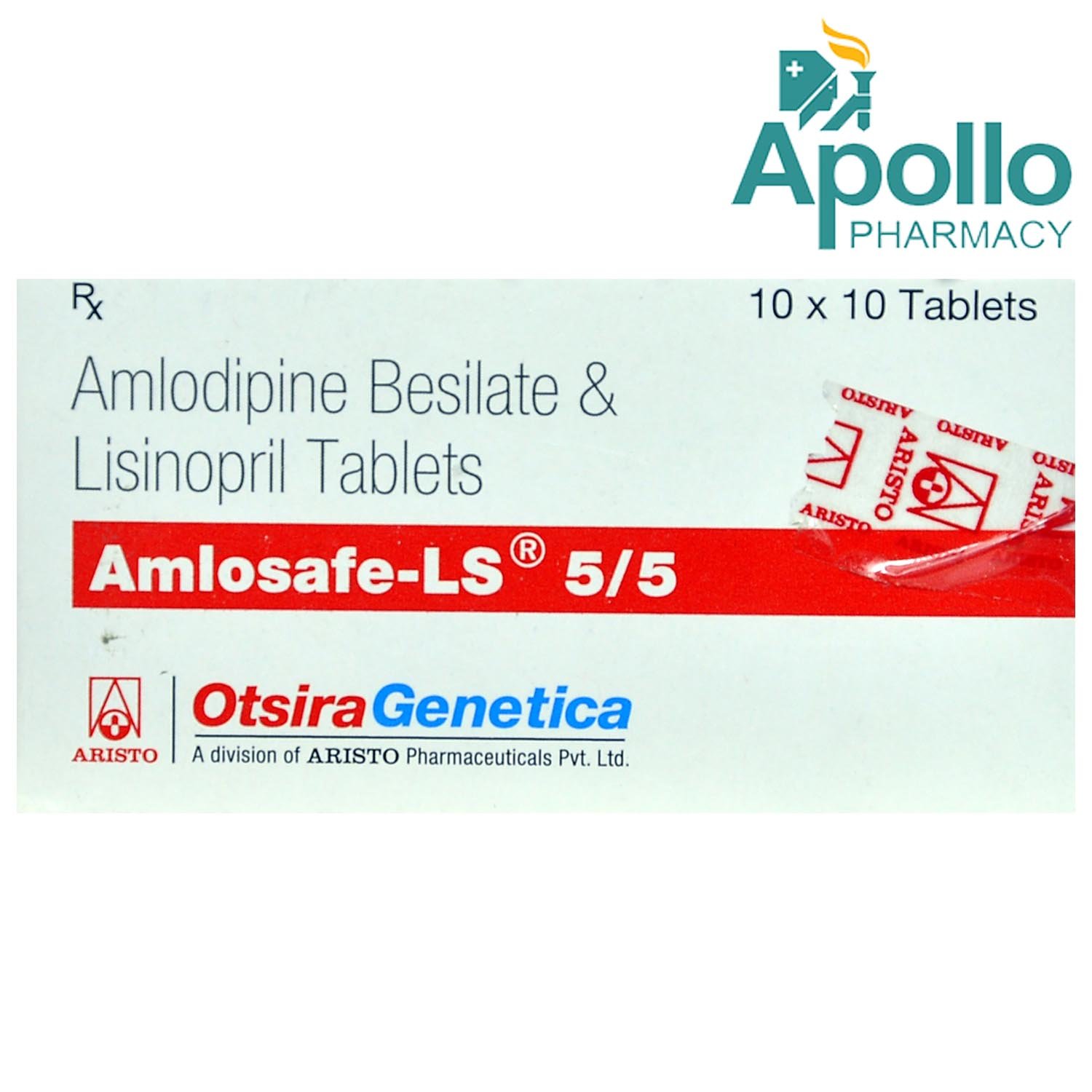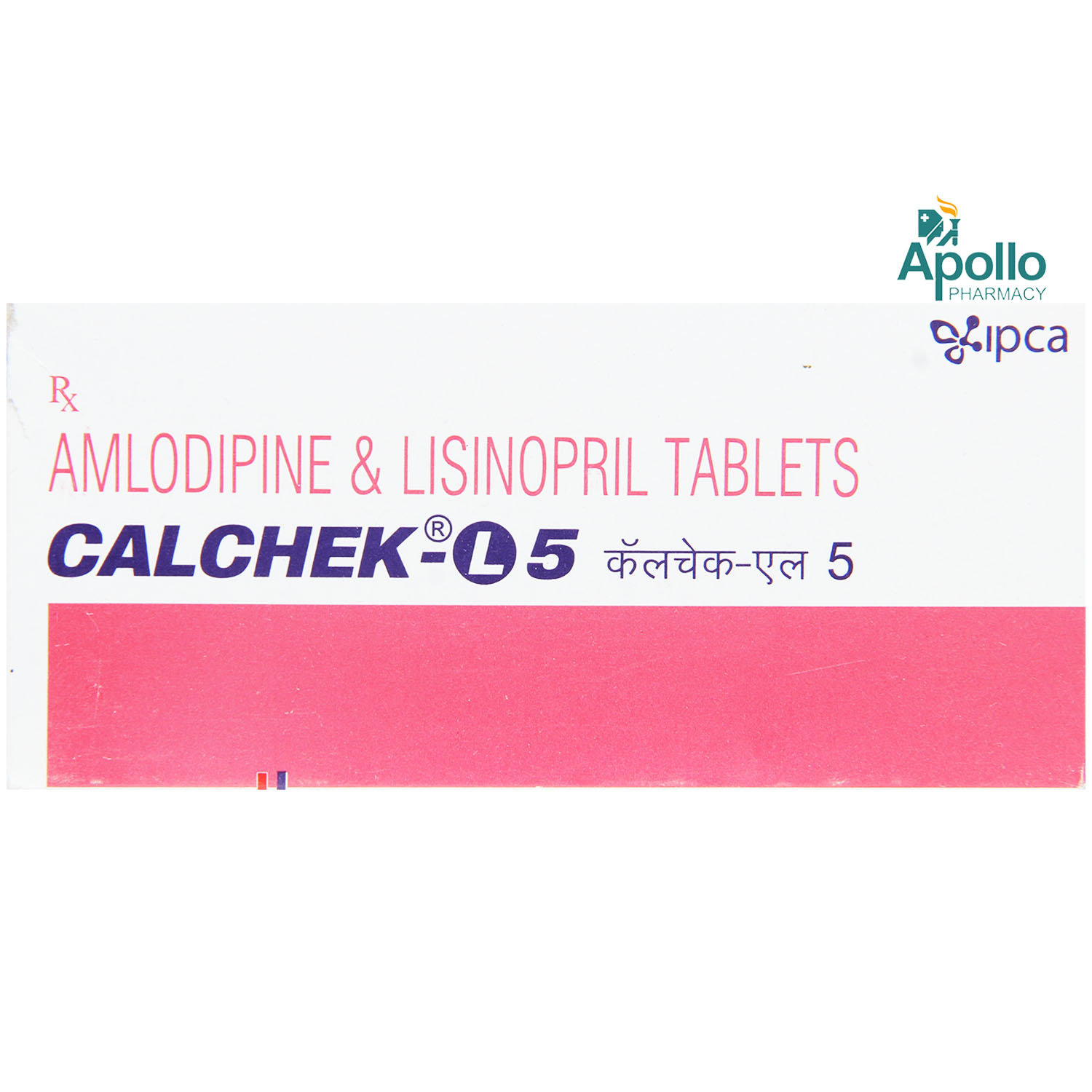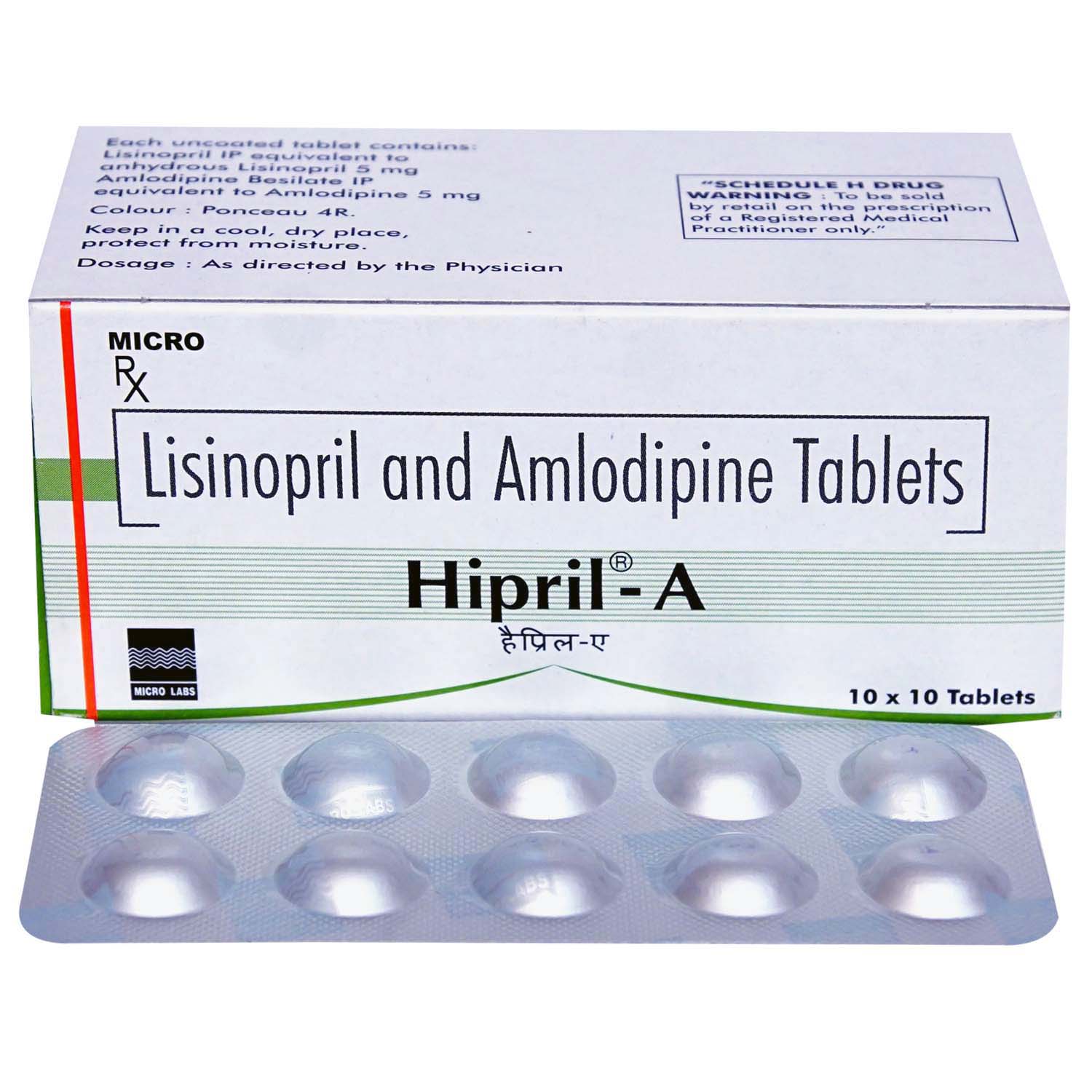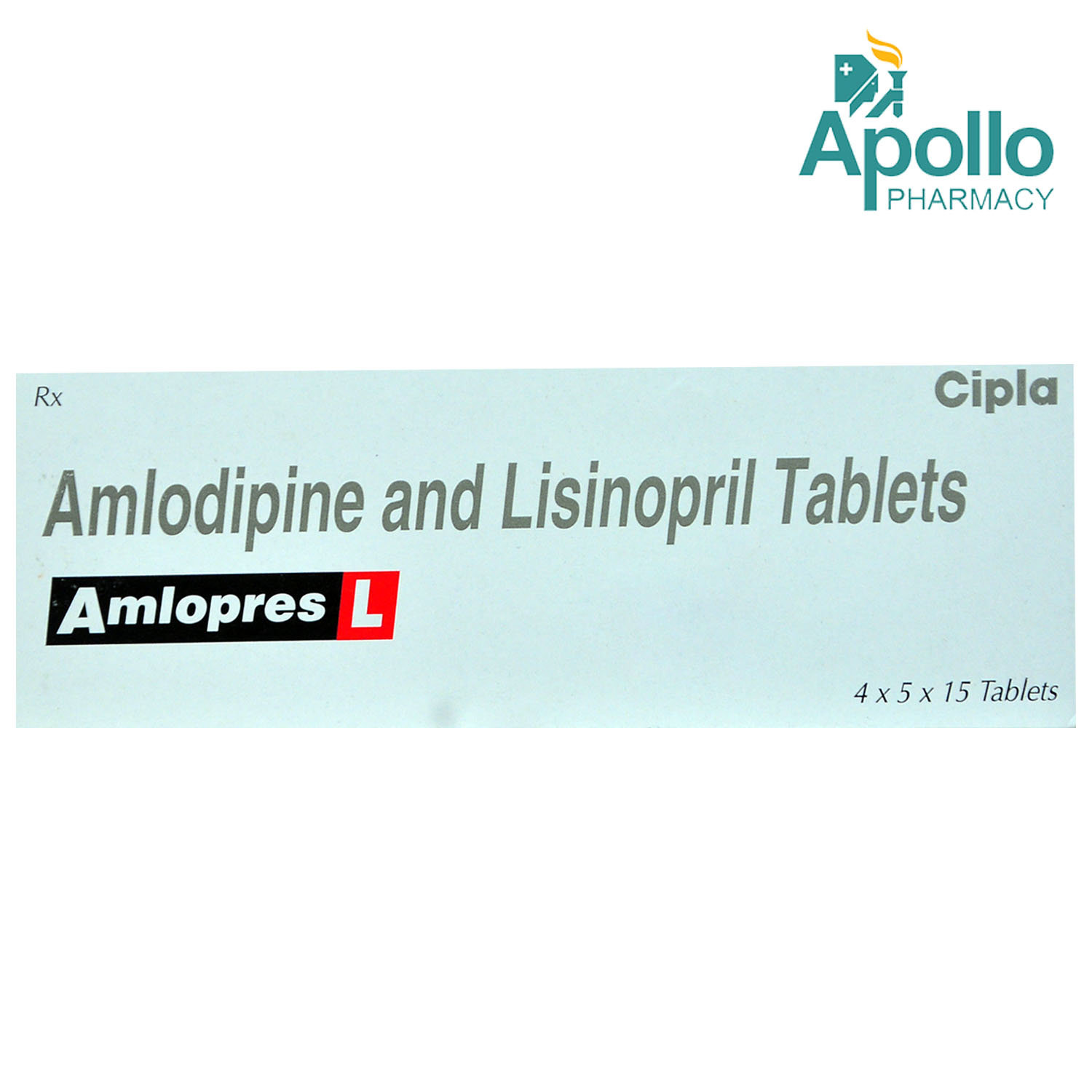Amlod-L Tablet 10's


MRP ₹56.5
(Inclusive of all Taxes)
₹8.5 Cashback (15%)
Provide Delivery Location
Online payment accepted
 Prescription drug
Prescription drugWhats That
Composition :
Manufacturer/Marketer :
Consume Type :
Return Policy :
About Amlod-L Tablet 10's
Amlod-L Tablet 10's belongs to the class of 'anti-hypertensive drugs', primarily used to treat hypertension (high blood pressure). Hypertension is a medical condition in which the blood exerts high pressure (force exerted by circulating blood) against blood vessels' walls. This condition makes the heart work harder in pumping blood to the whole body. Hypertension can cause severe health complications, including stroke, heart failure, heart attack, and kidney failure.
Amlod-L Tablet 10's is a combination of medicine that consists of Amlodipine (calcium channel blocker) and Lisinopril (angiotensin-converting enzyme inhibitor). Amlodipine belongs to the class of 'calcium channel blockers and is used to treat high blood pressure, Prinzmetal's or variant angina (chest pain), and other conditions caused by coronary artery disease. It relaxes blood vessels so that blood passes through them easily, lowering blood pressure. Amlodipine also improves blood supply to the heart muscle to receive more oxygen and thus preventing chest pain. Lisinopril belongs to the class of 'Angiotensin-Converting Enzyme (ACE) Inhibitors.' It relaxes and widens the blood vessels making it easier for the heart to pump blood throughout the body, lowering blood pressure. Lisinopril also decreases the body’s production of certain substances that raise blood pressure.
Amlod-L Tablet 10's is an orally administered drug in the form of a tablet and capsule. You can take Amlod-L Tablet 10's with food or without food. Swallow it as a whole with a glass of water. Do not chew, bite, or break it. Your doctor will advise you how often you take Amlod-L Tablet 10's based on your medical condition. In some cases, you may experience blurred vision, sweating, confusion, tiredness, stomach upset, flushing (sense of warmth in the face, ears, neck and trunk), dizziness, headache, and swelling of the ankles or feet. Most of these side effects of Amlod-L Tablet 10's do not require medical attention and gradually resolve over time. However, if the side effects are persistent, please contact your doctor.
Do not stop taking Amlod-L Tablet 10's without consulting your doctor since it may worsen your condition and increase the risk of future heart problems. Regular monitoring of blood pressure, electrolyte levels and kidney functioning is advised while taking Amlod-L Tablet 10's. Inform your doctor if you are suffering from kidney, liver or heart diseases. Please tell your doctor if you are taking other medicines or allergic to Amlod-L Tablet 10's. Reducing the amount of table salt (sodium chloride) in your food often relieves the body's swelling. Let your doctor know if you use any prescription and non-prescription medications you are taking, including vitamins, before starting Amlod-L Tablet 10's. If you are pregnant or breastfeeding, please tell your doctor so that the dosage of Amlod-L Tablet 10's can be prescribed accordingly.
Uses of Amlod-L Tablet 10's
Directions for Use
Key Benefits
Amlod-L Tablet 10's treats hypertension (high blood pressure) and consists of Amlodipine (calcium channel blocker) and Lisinopril (angiotensin-converting enzyme inhibitor). Amlodipine is a 'calcium channel blocker' and treats high blood pressure, Prinzmetal's or variant angina (chest pain), and other conditions caused by coronary artery disease. It relaxes blood vessels so that blood passes through them easily, lowering blood pressure. It also treats chest pain by improving the blood supply to the heart muscle to receive more oxygen. Amlodipine also improves a person's tolerance to exercise and keeps the blood pressure at acceptable levels. Lisinopril is an 'Angiotensin-Converting Enzyme (ACE) Inhibitor.' It relaxes and widens the blood vessels making it easier for the heart to pump blood throughout the body, lowering blood pressure.
Storage
Drug Warnings
- Do not use Amlod-L Tablet 10's if you are allergic to Amlod-L Tablet 10's or its components.
- Please inform your doctor if you are using any prescription and non-prescription medications, including vitamins, before starting Amlod-L Tablet 10's.
- Let your doctor know if you have any history of severe heart, kidney or liver diseases, high potassium levels (hyperkalaemia), bone marrow suppression, and aortic stenosis (heart valve problem).
- It is essential to inform your doctor if you are a breastfeeding mother before using Amlod-L Tablet 10's since Amlodipine may pass into the breast milk.
- Lisinopril is not recommended during pregnancy since it harms the unborn baby. Please ask your doctor if you plan to conceive or are pregnant before using Amlod-L Tablet 10's.
- Amlod-L Tablet 10's can increase the chances of light-headedness so rise slowly if you are sitting/lying and avoid operating any machine or doing any work that needs mental alertness.
Drug-Drug Interactions
Drug-Drug Interactions
Login/Sign Up
Using Amlod-L Tablet together with dantrolene may increase the risk of hyperkalemia (high blood potassium).
How to manage the interaction:
Taking Amlod-L Tablet with Dantrolene can cause an interaction, consult a doctor before taking it. You should seek medical attention if you experience nausea, vomiting, weakness, confusion, tingling of the hands and feet, a weak pulse, or a slow or irregular heartbeat. Do not stop using any medications without talking to a doctor.
Combining Aliskiren with Amlod-L Tablet can increase the potassium levels in the blood.
How to manage the interaction:
Although taking Aliskiren and Amlod-L Tablet together can result in an interaction, it can be taken if a doctor has prescribed it. However, consult a doctor if you experience symptoms including weakness, tiredness, confusion, numbness or tingling, and irregular heartbeats. Do not discontinue any medications without a doctor's advice.
Using Amlod-L Tablet and mitotane together may drastically lower Amlod-L Tablet blood levels, which makes the medicine less effective.
How to manage the interaction:
Although co-administration of Amlod-L Tablet with mitotane can result in an interaction, it can be taken if a doctor has advised it. Do not discontinue any medications without consulting a doctor.
Using phenobarbital and Amlod-L Tablet may drastically lower Amlod-L Tablet blood levels, which makes the medicine less effective.
How to manage the interaction:
Although co-administration of phenobarbital with Amlod-L Tablet can result in an interaction, it can be taken if a doctor has advised it. Do not discontinue any medications without consulting a doctor.
Coadministration of Amlod-L Tablet and carbamazepine together may significantly reduce Amlod-L Tablet blood levels, making the medicine less effective.
How to manage the interaction:
Although there is an interaction between Amlod-L Tablet with carbamazepine, it can be taken if a doctor has advised it. However, if you experience any unusual symptoms contact the doctor immediately. Do not stop using any medications without talking to a doctor.
Using Amlod-L Tablet and phenytoin together may drastically lower Amlod-L Tablet blood levels, which makes the medicine less effective.
How to manage the interaction:
Although Amlod-L Tablet with phenytoin can result in an interaction, it can be taken if a doctor has advised it. Do not discontinue any medications without consulting a doctor.
Using Amlod-L Tablet and primidone together may lower Amlod-L Tablet blood levels, which makes the medicine less effective.
How to manage the interaction:
Although co-administration of Amlod-L Tablet with primidone can result in an interaction, it can be taken if a doctor has advised it. Do not discontinue any medications without consulting a doctor.
Coadministration of lemborexant and Amlod-L Tablet may increase the blood levels of lemborexant.
How to manage the interaction:
Although co-administration of Amlod-L Tablet with Lemborexant can result in an interaction, it can be taken if a doctor has advised it. However, consult your doctor if you experience abnormal sleep patterns, worsening of depression, changes in heartbeat, or headache. Do not discontinue any medications without consulting a doctor.
Taking simvastatin with Amlod-L Tablet may result in considerably higher blood levels of simvastatin and may increase the risk of side effects (liver damage and rhabdomyolysis - an uncommon but serious illness characterized by the breakdown of skeletal muscle tissue).
How to manage the interaction:
Although taking Amlod-L Tablet with simvastatin can result in an interaction, it can be taken if a doctor has advised it. If you have unexplained muscular pain, soreness, or weakness while using simvastatin, especially if these symptoms are accompanied by fever or dark-colored urine, consult the doctor immediately. However, if you develop a fever, chills, joint pain or swelling, unusual bleeding or bruising, skin rash, itching, loss of appetite, fatigue, nausea, vomiting, dark colored urine, and/or yellowing of the skin or eyes, consult the doctor. Do not stop using any medications without a doctor's advice.
Co-administration of Amlod-L Tablet can make Sirolimus may increase the risk of angioedema (a condition associated with swelling of the face, eyes, lips, tongue, throat, and occasionally also the hands and feet).
How to manage the interaction:
There may be a possibility of interaction between Amlod-L Tablet and Sirolimus, but it can be taken if prescribed by a doctor. However, consult the doctor if you notice any swelling of the face, eyes, lips, tongue, throat, hands and feet or have trouble breathing or swallowing. Do not stop using any medications without a doctor's advice.
Drug-Food Interactions
Drug-Food Interactions
Login/Sign Up
Lentils, Orange Juice, Oranges, Raisins, Potatoes, Salmon Dried, Spinach, Sweet Potatoes, Tomatoes, Coconut Water, Beans, Beetroot, Broccoli, Bananas, Apricots, Avocado, Yogurt
How to manage the interaction:
Taking Amlod-L Tablet with potassium-containing salt substitutes or potassium supplements can cause high levels of potassium in the blood. Avoid taking potassium-containing salt substitutes or potassium supplements while being treated with Amlod-L Tablet.
Diet & Lifestyle Advise
- Keep your weight under control with body mass index (BMI) between 19.5 and 24.9.
- Do regular physical activity or exercise for at least 150 minutes per week, or about 30 minutes most days of the week. Doing this can help lower your raised blood pressure by about 5 mm of Hg.
- Limit sodium chloride intake (table salt) in your daily diet to 2300 mg daily or less than 1500 mg is ideal for most adults.
- If you are taking alcohol, use only one serving for women and two servings for men.
- Quit smoking to lower the risk of heart disease.
- Avoid chronic stress, as it can raise your blood pressure. Try to enjoy and spent time with your loved ones to cope with stress.
- Monitor your blood pressure daily, and if you notice any fluctuations frequently, please contact your doctor immediately.
- Try including heart-healthy omega-3 fatty acid-containing foods in your daily diet. You can also use low-fat cooking oils like olive oil, soybean oil, canola oil, and coconut oil to lower your elevated blood pressure.
Side Effects of Amlod-L Tablet 10's
- Confusion
- Sweating
- Tiredness
- Dizziness
- Headache
- Blurred vision
- Stomach upset
- Swelling of the ankles or feet
- Flushing (sense of warmth in the face, ears, neck and trunk)
Habit Forming
Therapeutic Class
All Substitutes & Brand Comparisons
RX
Out of StockStayHappi Amlodipine+Lisinopril 5mg/5mg Tablet
₹30
(₹2.7 per unit)
52% CHEAPERRX
Out of StockInace 5 mg/5 mg Tablet
₹26.25
(₹3.37 per unit)
40% CHEAPERRX
Out of StockPDPRIL-AM 5MG/5MG TABLET
Pharma Drugs & Chemicals
₹38
(₹3.42 per unit)
39% CHEAPER
Product Substitutes
Drug-Diseases Interactions
Drug-Diseases Interactions
Login/Sign Up
FAQs
Amlod-L Tablet 10's treats hypertension (high blood pressure) and consists of Amlodipine (calcium channel blocker) and Lisinopril (angiotensin-converting enzyme inhibitor). Amlodipine is a 'calcium channel blocker' and treats high blood pressure, Prinzmetal's or variant angina (chest pain), and other conditions caused by coronary artery disease. It relaxes blood vessels so that blood passes through them easily, lowering blood pressure.
Amlod-L Tablet 10's is recommended to use in dose and duration as advised by the doctor. Do not stop taking Amlod-L Tablet 10's on your own, as it may lead to a sudden rise in blood pressure and increases the risk of heart attack and stroke.
Amlod-L Tablet 10's may increase blood potassium levels in people with diabetes, poor kidney function, and patients using potassium-sparing diuretics or taking potassium supplements. Please consult your doctor before taking Amlod-L Tablet 10's if you have diabetes.
Amlodipine in Amlod-L Tablet 10's can cause ankle swelling upon long-term use. Please try to keep your feet in an elevated position when sitting for long hours. If the problem persists, please consult your doctor and do as advised.
Even though your blood pressure becomes normal after using Amlod-L Tablet 10's, it may switch back to high ranges if you stop using it. Your doctor may change the dosing schedule based on your blood pressure range.
Take the missed dose as soon as possible. However, if it is time for the next dose, skip the missed dose and return to your regular dosing schedule.
Drug-Drug Interactions Checker List
- SIMVASTATIN
- PREDNISOLONE
- BENDROFLUMETHIAZIDE
- NAPROXEN
- INSULIN GLARGINE
- PREGABALIN
- SITAGLIPTIN
- ALLOPURINOL
- SILDENAFIL
- METOPROLOL
- RAMIPRIL
- FUROSEMIDE
- IBUPROFEN
- METFORMIN
Special Advise
- Monitor your blood pressure regularly and seek medical advice if you notice any drastic fluctuations.
- Amlod-L Tablet 10's may affect patients with hepatic impairment, and hence it is used cautiously, and Liver function monitoring and Liver Function Tests are advised to monitor the liver enzyme changes.
- Your doctor may advise you to get a regular kidney function test and blood examinations for potassium levels and other electrolytes while using Amlod-L Tablet 10's to rule out any renal impairment.
Disease/Condition Glossary
Hypertension: When your blood pressure is too high, you have a chronic condition. The amount of blood pumped by the heart and the amount of resistance exerted by the arteries against the blood flow is called blood pressure. When the heart pumps more blood, the arteries narrow, and the blood pressure rises. Uncontrolled blood pressure can lead to serious heart problems such as stroke and heart attack. High blood pressure can also damage the brain (stroke) and lead to kidney failure. The systolic and diastolic pressures of blood are measured. The contraction and relaxation of the heart are represented by systolic blood pressure. Diastolic pressure is exerted in the blood vessels when the heart is at rest and not beating. The ideal blood pressure range is 90/60 mmHg to 120/80 mmHg. When systolic blood pressure exceeds 140mmHg, and diastolic pressure exceeds 90mmHg, hypertension is diagnosed. Hypertension symptoms include headaches, nosebleeds, vomiting, and chest pain.

Have a query?
Alcohol
Safe if prescribed
Alcohol may lower your blood pressure. Limit or avoid consuming alcohol while on treatment with Amlod-L Tablet 10's is advisable.
Pregnancy
Consult your doctor
Lisinopril in Amlod-L Tablet 10's is a pregnancy D category drug and is not recommended during pregnancy since it causes harmful effects on the developing foetus. However, it is advised to seek medical advice before using Amlod-L Tablet 10's if you plan to conceive or pregnant.
Breast Feeding
Consult your doctor
There are limited studies on how Amlod-L Tablet 10's affects breastfed infants. However, Amlodipine in Amlod-L Tablet 10's passes into the breast milk during breastfeeding. Please consult your doctor before using Amlod-L Tablet 10's if you are a lactating mother.
Driving
Safe if prescribed
Amlod-L Tablet 10's may cause side effects from lowering blood pressure, such as dizziness or tiredness. If you feel dizzy or tired when taking this medicine, do not drive or use any tools or machines.
Liver
Consult your doctor
Let your doctor know if you have any history of liver diseases before using Amlod-L Tablet 10's. Your doctor may adjust the dose based on your condition.
Kidney
Consult your doctor
Let your doctor know if you have any history of kidney diseases before using Amlod-L Tablet 10's. Amlod-L Tablet 10's is primarily eliminated by the kidney and can be accumulated in patients with renal impairment. Your doctor may adjust the dose based on your condition.
Children
Safe if prescribed
Amlod-L Tablet 10's is not recommended for children as efficacy and safety have not been established.












